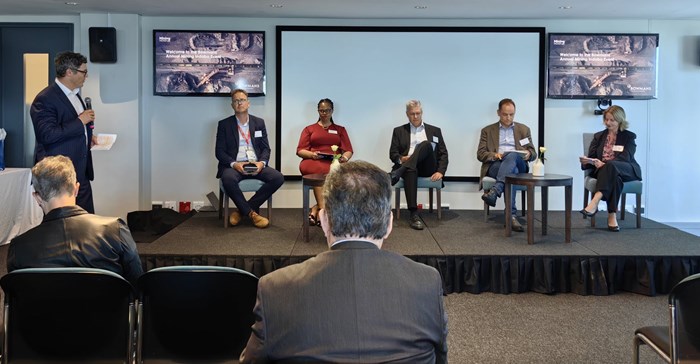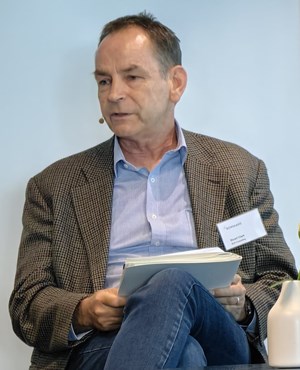
The panel at the Bowmans 2024 Mining Indaba Event included (from left) Dr Rebecca Maserumule, director for hydrogen and energy at DSI, Bart by Bart Nieuwoudt, lead legal specialist at Sasol, Stuart Heather-Clark, Africa Power Sector Energy Transition Lead at SLR Consulting, Claire Tucker head of our public law and regulatory practice, Bowmans.
President Ramaphosa first unveiled his administration’s green hydrogen ambitions in his 2021 State of the Nation Address that highlighted government’s collaboration with various partners including the private sector and academia, has been diligently working on the development of hydrogen fuel cell and lithium battery storage technologies for over a decade.
This endeavour serves two significant developmental objectives. Firstly, it presents the potential for a new, renewable energy source. Secondly, it paves the way for the establishment of new uses and markets for the platinum group metals (PGM), which are found in abundance in our nation.
PGMs were, at the time, a crucial raw material used in the production of electrolysers.
Felix Njini and Veronica Brown 5 Feb 2024 Ramaphosa stated, “Through its Hydrogen South Africa Strategy, the government and its partners have successfully utilised hydrogen fuel cells to supply electricity to schools and field hospitals established as part of the country’s response to Covid-19.
“Now, after a decade of investment, we are prepared to transition from research and development to manufacturing and commercialisation,” he said before announcing the establishment of a ‘Platinum Valley’ – an industrial cluster that brings together various hydrogen applications in the country to form an integrated hydrogen ecosystem.
’Technology is moving fast’

Stuart Heather-Clark
“I really see that technology is evolving almost in a monthly basis in terms of new minerals, new catalysts. Some of the research is moving away from platinum, so it's interesting,” SLR Consulting power sector energy transition lead Stuart Heather-Clark explained to the audience at Bowmans annual Mining Indaba event, held on 5 February 2024.
“We need to work with our clients to be more flexible and make sure that the permits we’re getting is more flexible. Some of the projects will go through two to three years of feasibility study, and the technology can radically change in that time.”
Developers are looking for the most efficient technology two or three years down the line
That technology development cycle is at odds with the president’s original projections of the PGM industry’s role in the green hydrogen economy.
In a study published in Nature Energy in 2022, scientists discovered a method to combine iron with nitrogen and carbon to create a catalyst that is not only efficient and durable but also inexpensive.
This study was in line with the three primary objectives mandated by the US Department of Energy (DOE) for fuel cell research.
The study’s lead author, Dr Gang Wu, said it was a “significant breakthrough that will eventually help unleash the tremendous potential of hydrogen fuel cells”.
Creating demand
Fuel cells, similar to batteries but with continuous power supply, are promising for their low emissions and versatility in powering various systems.
However, their commercialisation is limited by the need for expensive catalysts, typically rare platinum-group metals. There is a significant will behind finding more affordable alternatives and advancing the potential of hydrogen fuel cells.

Dr Rebecca Maserumule
“The reason why we talked about the platinum valley was because we wanted to aggregate projects from different organisations together to create a sufficient demand for hydrogen in a geographic area,” Dr Rebecca Maserumule, chief director for hydrogen and energy at the Department of Science and Innovation (DSI) told Bizcommunity
“We were anchored by the Mogalakwena Platinum Project by Anglo American. I would say that one of the challenges has been finding funds for those projects. That project was registered as a strategic infrastructure project, so that helped. And we are responsible for individual projects with this in the Platinum Valley.”
The feasibility study was a collaboration between Anglo American, DSI, the South African National Energy Development Institute (SANEDI), Engie and Bambili Energy to explore the potential for a hydrogen valley anchored in the platinum group metals-rich Bushveld geological area, along the industrial and commercial corridor to Johannesburg and to the south coast at Durban.
The project report proposed nine promising pilot projects to kickstart the Hydrogen Valley in the near term, covering different applications of hydrogen such as fuel cell mining trucks, buses, ammonia production, and office building power.
Felix Njini and Clara Denina 7 Dec 2023 Estimated socioeconomic impact of the Hydrogen Valley could potentially add $3.9-8.8bn to GDP and create 14,000-30,000+ jobs per year by 2050, while also contributing to the decarbonisation of the energy system and the just transition of the workforce.
Dr Maserumule, however, tells Bizcommunity that the most important step for South Africa is to start developing for the current demand. “We actually need to start manufacturing electrolysers in South Africa, creating jobs as well as beneficiating our platinum to benefit the people who live in this country.”
She does pose an interesting question about the hydrogen economy, though: “If you as a country are producing electrolysers and you have your own hydrogen aspirations, are you going to use your electrolysers for your own country and export hydrogen or are you gonna ship to other countries?”

































































